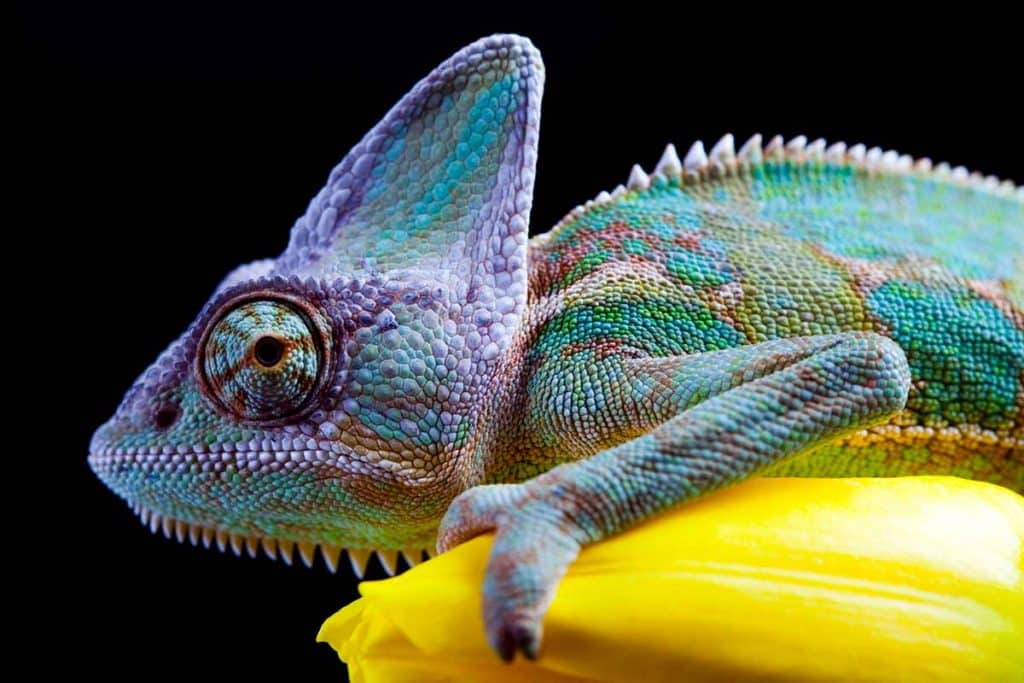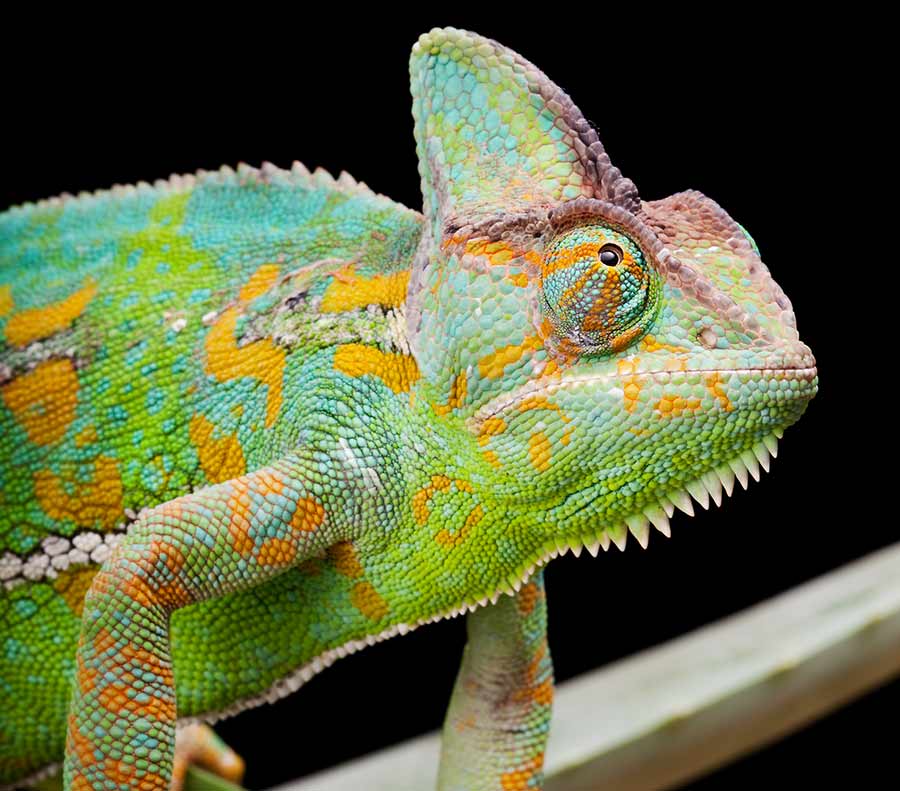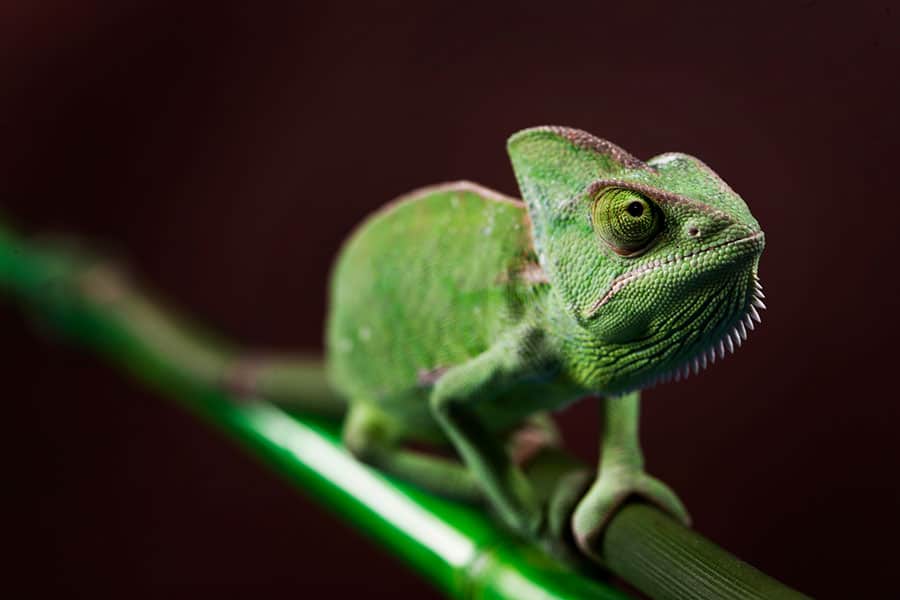Chameleons are fascinating creatures. They are brightly colored, can change their skin colors, have amazing tongues, and move in a unique way. Why wouldn’t you want one as a pet? If you’ve considered adopting one of these fun little lizards, you might be asking: are chameleons good pets?
The answer is not a simple yes or no. There are many factors that go into taking care of a chameleon, and all of them have something that can go wrong. Chameleons are not very forgiving reptiles if you make any mistakes with their care requirements, and their health can take a sharp turn for the worse at the slightest inconvenience.
Experienced reptile owners know how to monitor and adjust enclosure settings like temperature and humidity to suit their animals. Beginners in the reptile industry may not have all of the care requirements down to an art, and so there is larger room for error. Any error when caring for a chameleon can be disastrous.
However, if you are thinking about owning a chameleon, read on to see what makes them a rewarding challenge. If they are too challenging for your experience level right now, then check out our top three lizards for absolute beginners!
Caring for a Pet Chameleon Is a Bit Tricky
The main reason why chameleons are challenging to take care of is because they have tricky and very precise care requirements. If their care requirements are not correctly maintained or set up, your chameleon can get sick pretty quickly, and they do not recover from illnesses very well.
Maintaining the following enclosure settings are crucial to your chameleon’s health and happiness. Failure to properly maintain one or more of these settings is the most common cause of accidental death in pet chameleons. However, don’t worry, it’s not all bad news! We have plenty of useful instructions and tips on how to ensure these settings are never a problem for you.
Enclosure and Ventilation
A chameleon needs to be housed in a screened enclosure. This is because they get stressed out when they come face to face with another chameleon. Unfortunately, their brains are not evolved enough to recognize their own reflection in a glass enclosure!
Chameleons also need plenty of ventilation in captivity. Because screened enclosures have lots of tiny holes throughout, they provide adequate ventilation for lizards like chameleons. This is good because chameleons suffer in stagnant (non-moving) air. Stagnant air also commonly causes respiratory infections in chameleons.
However, too much ventilation can interfere with the humidity and temperature settings of your enclosure. You will need to keep a very careful eye on these levels to adjust their misting schedule or temperature settings if there is too much air movement.
Every chameleon enclosure needs a reliable hygrometer and a
Temperature
A chameleon’s enclosure must have a warm side and a cooler side with a gentle temperature gradient between them. This is because chameleons are ectothermic; they use external sources of heat to regulate their body temperatures and metabolism.
Your chameleon needs to be able to move between these temperature areas or along the temperature gradient to regulate itself. Remember that chameleons are arboreal and will rarely come down to the floor of their enclosure, so their temperature gradient needs to be adjusted appropriately.
Each species of chameleon will have slightly different temperature settings. However, the average temperature setting is around 75°F on the cool side and 90°F in the basking spot. The basking spot is the warmest part of the enclosure. It is usually directly under a heating bulb.
There should be two thermometers in the enclosure, one on the cool side and one under the basking spot so that you can keep a careful eye on the temperature gradient. Like we touched on earlier, it’s best to simply opt for a dual
Here are the recommended temperature ranges for three of the most popular pet chameleon species:
- Jackson’s chameleon:
Basking spot: 86°F
Coolest temperature: 75°F - Veiled chameleon:
Basking spot: 95°F
Coolest temperature: 75°F - Panther chameleon:
Basking spot: 90°F
Coolest temperature: 75°F
Humidity
Your chameleon needs to have their humidity levels maintained between 65% and 80% at all times. If the humidity drops lower than 65%, then your chameleon is at huge risk of dehydration. However, if the humidity level becomes higher than 80%, then your chameleon is at risk of developing respiratory problems.
Humidity can be controlled by misting the enclosure twice a day with a handheld mister, provided the enclosure is in a room that receives good ventilation and does not dry out quickly.
Implementing a misting or fogging system is an excellent way to maintain the humidity levels in the enclosure in case you need to go away for the weekend or are afraid of forgetting to mist by hand.
Water
Chameleons do not drink water from a dish. Their brains do not recognize standing water as water! They only drink water from droplets on plants and other surfaces.
Using a misting or fogging system that is directed at a specific leaf or branch will provide a steady supply of droplets. However, you can also purchase or make a dripper to provide your chameleon with enough water to stay hydrated.
Dehydration is common in chameleons and can prove to be fatal pretty quickly if not treated immediately. Check out our guide on spotting and caring for a dehydrated chameleon!
Food
Chameleons need a wide variety of insects in their diet to stay happy and healthy. They tend to become bored if they are fed the same insects over and over again. If they get bored with their food, they can simply stop eating for days or even weeks at a time!
Some staple insects that should be on rotation as part of your chameleon’s diet are:
- Hornworms
- Phoenix worms (also known as black soldier fly larvae)
- Crickets
- Locusts
- Mantids
- Blue/Green bottle flies
In addition, your chameleon will thrive if they are given a treat to look forward to once or twice a week. Treat items can include fattier insects such as:
- Waxworms
- Butterworms
- Morio worms
Be sure to avoid feeding insects like waxworms regularly, though, as they can cause obesity in reptiles due to their high fat content. Treat insects should never be part of your chameleon’s staple diet.
All insects that light up, such as glow worms and lightning bugs, should be strictly avoided, as they are highly toxic and sometimes even fatal to reptiles.
Chameleons do not usually eat greens and fruits in the wild. However, you can try them out every now and then and see if your chameleon likes them in their diet. Most fruits, veggies, and greens are safe, but there are some that are toxic to reptiles. Toxic foods include:
- Avocado
- Rhubarb
- All citrus fruits
Overall, keep your chameleon’s diet varied, interesting, and above all, healthy!
Stress
Chameleons are notoriously easily stressed lizards. As we have already mentioned, even their own reflection stresses them out!
Chameleons are also known to stop eating and drinking altogether due to stress. Their stress usually comes from their environment. If any of their enclosure settings are even slightly off, this will cause them stress.
Additionally, if there is a lot of activity, loud noise, or bright lights surrounding their enclosure, then they can get stressed out very easily, especially if they do not have enough decorations or foliage in their enclosure to hide in. Be sure to keep your chameleon’s enclosure in a quiet, calm room away from any commotion or traffic in your home.
Prepare Your Chameleon’s Habitat in Advance!
If you’re convinced that chameleons are good pets for you to have, this is one of the first things you should set up.
Maintaining a chameleon enclosure is tricky, but setting things up before you bring your new pet home can make things a lot easier for you.
Get your entire setup ready and working at least a week before your chameleon arrives! During this time, you can see how the temperature and humidity changes at night, when a window is opened, or when it rains outside. You’ll be able to do plenty of troubleshooting beforehand to ensure everything is just right for your new scaly friend.
Running your enclosure system before bringing your chameleon home will also allow you to get familiar with it and work out any problems or faulty items like lamps or misters before your chameleon is placed in their new environment.
Remember, even simply moving to a new location is extremely stressful for a chameleon. Making sure everything runs smoothly before placing them in their new enclosure will help minimize their initial stress significantly.
FAQs About Taking Care of Chameleons
Do chameleons like to be handled?
Chameleons do not do well with frequent handling or with beginner reptile keepers. They are very shy, anxious animals who are easily stressed by their surroundings.
Instead of getting a chameleon, consider bringing home a crested gecko, a bearded dragon, or an Ackie monitor. Check out our guide on the best lizards for handling for more details.
Why do chameleons need such high humidity levels?
Chameleons come from very hot and humid tropical rainforests. This means their bodies are built to withstand high humidity from frequent raining. This also means without high humidity in their habitat they will dehydrate very quickly.
Are chameleons expensive pets?
The chameleon itself is not too expensive, depending on the species you get. What is expensive, however, is their enclosure setup and food costs. Chameleons are high maintenance and need constant care, and this care comes with costs.
Do chameleons bite humans?
Chameleons are not generally aggressive with their owners. However, they do not show a lot of affection like a bearded dragon, for example, and and as mentioned, they don’t tolerate being handled, either.
Wrapping Up…
Chameleons can make good pets as they are interesting creatures to watch and care for. They are beautiful, active, curious, and they will provide you with endless hours of viewing pleasure and companionship.
However, chameleons are very unforgiving lizards if mistakes are made with their care requirements, so it is best to have some experience in keeping reptiles before you decide to get a chameleon.
With all of this information, we hope you are able to make the most educated decision and take the very best care of your chameleon!






